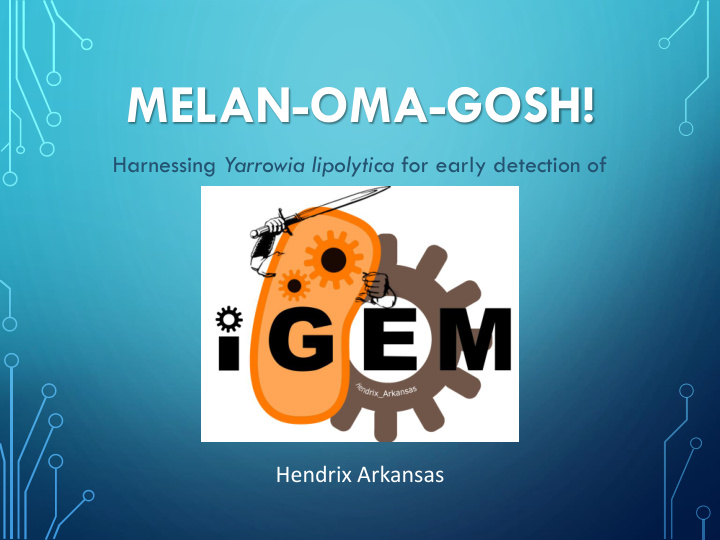



MELAN-OMA-GOSH! Harnessing Yarrowia lipolytica for early detection of cancer Hendrix Arkansas
Detecting Melanoma through an Alkane-Based Biosensor • Why is cancer an Background important problem? • How is the problem currently addressed? • How do we plan to address the problem? • Where did we get our idea? • How will our machine work?
Why is combating cancer important? • Cancer is a leading cause of death world wide. • Most common form of cancer in the U.S. is skin cancer. • The most deadly form of skin cancer is melanoma. • Late stage melanoma 5 year survival rate = 15%. • With detection and treatment before metastasis, 5 year survival rate = 99%. American Cancer Society. 2014. “Cancer facts & Figures 2014.” www.cancer.org/research/cancerfactsstatistics/cancerfactsfigures2014/index
MELANOMA & ARKANSAS National Cancer Institute & CDC. 2014. “State Cancer Profiles - Arkansas. ” http://statecancerprofiles.cancer.gov/recenttrend/index.php?0&05&0&9599&001&999&00&0&0&0&1#results
CURRENT MELANOMA DETECTION Adapted from American Academy of Dermatology. 2014. “Melanoma: Signs and Symptoms.” https://www.aad.org/dermatology-a-to-z/diseases-and-treatments/m---p/melanoma/signs-symptoms
Crowley, A. 2013. “How my beloved dog found my cancer” http://www.telegraph.co.uk/lifestyle/pets/9935073/How-my-beloved-dog-found-my-cancer.html
HOW DO DOGS DO IT? Volatile compounds
HOW DO DOGS DO IT? Volatile compounds DETECTION
MELANOMA PRODUCES VOLATILE COMPOUNDS Abaffy T. et al. 2011. “ A case report - Volatile metabolomic signature of malignant melanoma using matching skin as a control” Journal of Cancer Science Therapy 3(6): 140 – 144.
INTRODUCING YARROWIA LIPOLYTICA • Non-conventional yeast • Used in industrial applications • Efficient secretory pathway • Useful for Synthetic Bio applications • Able to use alkanes as sole carbon source • Inducible • Only works in the absence of other carbon sources
ALKANE RESPONSE IN Y. LIPOLYTICA 1 Yamagami S. et. Al (2004). “ A Basic Helix-Loop-Helix Transcription Factor Essential for Cytochrome P450 Induction in Response to Alkanes in Yeast Yarrowia lipolytica ” Journal of biological chemistry ( 279:22183-22189.)
Detecting Melanoma through an Alkane-Based Biosensor • What is the Approach structure of our construct? • What are our experimental goals? • How do we address those goals?
WHAT IS THE STRUCTURE OF OUR CONSTRUCT? K592009 Y. lipolytica expression vector Leu2 pBR322 Docking
2014 EXPERIMENTAL GOALS Reporter Part Testing Generation Assemble & Test Biosensor
Gal 1 CYC1t K592009 CEN6/ARSH4 origin antibiotic resistance
Gal 1 K592009 CYC1t Gal 1 K592009 CEN6/ARSH4 CEN6/ARSH4 K592009 Gal 1 CYC1t Gal 1 K592009 Blue CEN6/ARSH4
ORIENTATION SCREEN M 1 2 3 4 5 700bp - Agarose gel electrophoresis
COLORING S. CEREVISIAE SC-URA (GLU) SC-URA (GAL) Negative control Positive Control ~72 hours growth
FLUORESCENT PROTEINS White Light UV Light Control P416-Gal1 S. cerevisiae p416-Gal1GFP Dissection microscope with fluorescent capabilities ~24 hours of growth!
FLUORESCENT PROTEINS UV Light + UV Light + White Light Green Filter Red Filter Control p416-Gal1 S. cerevisiae p416-Gal1 GFP S. cerevisiae p416-Gal1 RFP Fluorescent microscopy ~24 hours of growth!
PARTS RFP/GFP Y. lipolytica expression vector Leu2 pBR322 Docking
E X 3 x ARE1 167bp, too big for oligo synthesis
E X 3 x ARE1 E X 3 x ARE1 divided into 2 parts
E X 3 x ARE1 E X E X 2 parts divided into 4 oligos
E X S P pSB1C3 pSB1C3 origin antibiotic resistance 3 x ARE1 E X S P pSB1C3 origin antibiotic resistance
In Summary Reporter Gene Part Construction • All parts transformed Testing into pSB1C3 plasmid • S. Cerevisiae is able to backbone. express the blue • Verified by restriction chromoprotein and both analysis. RFP and GFP • Awaiting sequence • Blue chromoprotein verification. expression seen after 72 hrs. • RFP & GFP expression seen after 24 hrs.
Detecting Melanoma through an Alkane-Based Biosensor Future • Reporter time course. Directions • Assemble device via biobrick assembly. • Clone device into Y. Lipolytica expression vector and transform into yeast • Test Construct.
TESTING STRATEGIES Culture Y. Soak paper in lipolytica volatile upside down on hydrocarbons media lacking carbon source
Detecting Melanoma through an Alkane-Based Biosensor Implications
ATTRIBUTIONS Faculty Advisor: Team Members: Dr. Richard Murray Noah Beggs Seana Corbin Collaborators: Chase Davis Dr. A. Caro Krystal Kim Dr. A. Duina Dr. A. Schurko Alex McIntyre Jordan Spennato Funding : Jay Stanley Hendrix Odyssey Sponsors : BioBasic
Recommend
More recommend